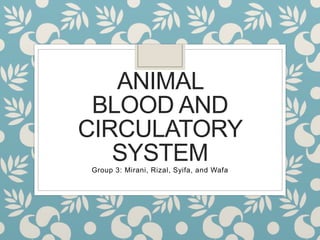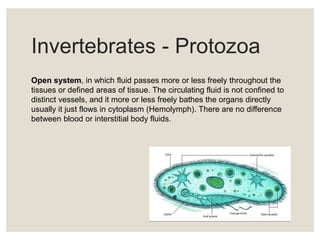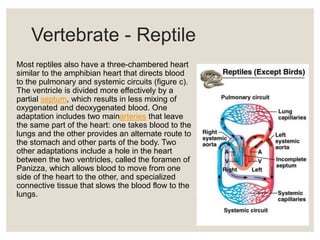Animal circulatory system
- 1. ANIMAL BLOOD AND CIRCULATORY SYSTEMGroup 3: Mirani, Rizal, Syifa, and Wafa
- 2. Blood
- 3. Components Blood is made up of four major components: ◦ Plasma: the liquid portion. ◦ Red blood cells. ◦ White cells. ◦ Platelets.
- 4. Red blood cells ◦ RBCs lose their nucleus at maturity. ◦ Make up about 99% of the blood’s cellular component. ◦ Red color is due to hemoglobin. ◦ Carry out oxygen and nutrient all over the body
- 5. Hemoglobin ◦ Hemoglobin is a complex protein made up of four protein strands, plus iron-rich heme groups. ◦ Each hemoglobin molecule can carry four oxygen atoms. The presence of oxygen turns hemoglobin bright red.
- 6. White cells ◦ White blood cells defend against disease by recognizing proteins that do not belong to the body. ◦ White cells are able to ooze through the walls of capillaries to patrol the tissues and reach the lymph system.
- 7. Platelets ◦ Platelets are cell fragments used in blood clotting. ◦ Platelets are derived from megakaryocites. Because they lack a nucleus, platelets have a short lifespan, usually about 10 days.
- 9. Circulatory system, system that transports nutrients, respiratory gases, and metabolic products throughout a living organism, permitting integration among the various tissues. The process of circulation includes the intake of metabolic materials, the conveyance of these materials throughout the organism, and the return of harmful by- products to the environment. Circulatory systems generally have three main features: ◦ Fluid (blood or hemolymph) that transports materials ◦ System of blood vessels ◦ A heart to pump the fluid through the vessels
- 10. Types of circulatory systems Animals that have a circulatory system have one of two kinds: ◦ Open: fluid is circulated through an open body chamber. ◦ Closed: fluid is circulated through blood vessels.
- 11. Open system ◦ Open circulatory system – No distinction between blood and the interstitial fluid; hemolymph ◦ Most Molluscs and Arthropods ◦ A tubular muscle, or heart, pumps hemolymph through a network of channels and body cavities, before draining back to the central cavity ◦ Hemolymph directly bathes the internal organs
- 12. Closed system ◦ Closed circulatory system – The circulating fluid, or blood, is enclosed within blood vessels that transport it away from – and back to – the heart ◦ All vertebrates, cephalopod molluscs, and annelids ◦ Consists of heart, blood vessels and blood
- 14. Invertebrates - Protozoa Open system, in which fluid passes more or less freely throughout the tissues or defined areas of tissue. The circulating fluid is not confined to distinct vessels, and it more or less freely bathes the organs directly usually it just flows in cytoplasm (Hemolymph). There are no difference between blood or interstitial body fluids.
- 15. Invertebrates – Porifera Sponges have no real circulatory system. Sponges have flagellated cells over the surface of their bodies, these are cells that have tails that wiggles. The collective effort of all these cells creates a water current through the many porous openings in the sponges body. It's a water based circulatory system.
- 16. Invertebrates - Cnidarians Jellyfish Jellyfish are such a unique kind of marine animal that they actually dont have a specialized circulatory system. They dont even have a specialized respiratory system. They can easily absorb oxygen when needed through their thin bodies. Coral Corals, Coelentrerates, have a gastrovascular system. A gastrovascular system is a type of system where the circulatory system and the digestive system are meshed together. The gastrovascular system in the Coral actually gives better circulation through the many species of fish that live symbiotically with it.
- 17. Invertebrates - Nematodes Nematodes doesn't have a circulatory system as you can see in the diagram below. There is no heart so there are no blood vessels. Instead minerals are transferred throughout the body via fluid in the Pseudocoelom
- 18. Invertebrates - Platyhelminthes Platyheminthes lack a circulatory system but are able to obtain oxygen and waste to their body cells through diffusion. Instead they actually have a gastrovacular cavity that has one opening. Platyheminthes can diffuse there food without the need for circulatory, respiratory, and excretion systems. Flatworms have specialized cells called flame cells that remove excess water.This could help in disposing waste that they could have diffused throughout their bodies.
- 19. Invertebrates - Annelids Annelids has a closed circulatory system. A closed circulatory system means that the blood is confined to blood vessels and its blood recirculates so it gets maximum use. The worm uses its bodies suface area to absorb oxygen from the soil instead for using lungs or gills. The oxygen absorbed is then taken into the dorsal blood vessels and travels to five hearts by the esophagus. At the esophagus, it pumps it to the lower ventral blood vessels which then pumps the oxygen to all organs in need. To complete the loop of the circulation, in each segment there is a small blood vessel that sends the blood from the ventral vessel back to the dorsal blood vessel.
- 20. Invertebrates - Mollusc Mollusks have an open circulatory system, meaning the blood does not circulate entirely within vessels but is collected from the gills, pumped through the heart, and released directly into spaces in the tissues from which it returns to the gills and then to the heart. Such a blood-filled space is known as a hemocoel or blood cavity. In the mollusks, the hemocoel has largely replaced the coelom, which is reduced to a small area around the heart and to the cavities of the organs of reproduction and excretion.
- 21. Invertebrate - Echinodermata Echinoderms have an open circulatory system with cilia circulating the fluids through each arm. Echinoderms have a network of fluid-filled canals that function in gas exchange, feeding and in movement. The network contains a central ring and areas which contain the tube feet which stretch along the body or arms. The tube feet poke through holes in the skeleton and can be extended or contracted. They do not have a true heart.
- 22. Invertebrate - Arthropods Arthropods have an open circulatory system. In this type of system, there is neither a true heart or capillaries as are found in humans. Instead of a heart there are blood vessels that act as pumps to force the blood along. Instead of capillaries, blood vessels join directly with open sinuses. "Blood," actually a combination of blood and interstitial fluid called 'hemolymph', is forced from the blood vessels into large sinuses, where it actually baths the internal organs.
- 23. Vertebrate - Amphibians Amphibians have a three-chambered heart that has two atria and one ventricle rather than the two-chambered heart of fish (figure b). The two atria receive blood from the two different circuits (the lungs and the systems). There is some mixing of the blood in the heart's ventricle, which reduces the efficiency of oxygenation. The advantage to this arrangement is that high pressure in the vessels pushes blood to the lungs and body. The mixing is mitigated by a ridge within the ventricle that diverts oxygen-rich blood through the systemic circulatory system and deoxygenated blood to the pulmocutaneous circuit where gas exchange occurs in the lungs and through the skin. For this reason, amphibians are often described as having double circulation.
- 24. Vertebrate - Pisces Fish have a single circuit for blood flow and a two-chambered heart that has only a single atrium and a single ventricle (figure a). The atrium collects blood that has returned from the body, while the ventricle pumps the blood to the gills where gas exchange occurs and the blood is re-oxygenated; this is called gill circulation. The blood then continues through the rest of the body before arriving back at the atrium; this is called systemic circulation. This unidirectional flow of blood produces a gradient of oxygenated to deoxygenated blood around the fish's systemic circuit. The result is a limit in the amount of oxygen that can reach some of the organs and tissues of the body, reducing the overall metabolic capacity of fish.
- 25. Vertebrate - Reptile Most reptiles also have a three-chambered heart similar to the amphibian heart that directs blood to the pulmonary and systemic circuits (figure c). The ventricle is divided more effectively by a partial septum, which results in less mixing of oxygenated and deoxygenated blood. One adaptation includes two mainarteries that leave the same part of the heart: one takes blood to the lungs and the other provides an alternate route to the stomach and other parts of the body. Two other adaptations include a hole in the heart between the two ventricles, called the foramen of Panizza, which allows blood to move from one side of the heart to the other, and specialized connective tissue that slows the blood flow to the lungs.
- 26. Vertebrate – Aves and Mammal In mammals and birds, the heart is also divided into four chambers: two atria and two ventricles (figure d). The oxygenated blood is separated from the deoxygenated blood, which improves the efficiency of double circulation and is probably required for the warm-blooded lifestyle of mammals and birds. The four- chambered heart of birds and mammals evolved independently from a three-chambered heart.
- 27. VIDEO



























